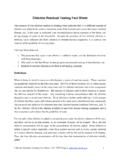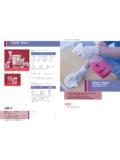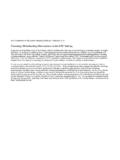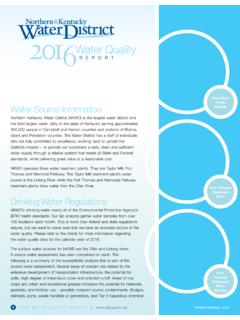Transcription of Service Availability andReadiness and Readiness …
1 SARA1| Service Availability and Readiness assessment ( sara ) A methodology for measuring health systems strengthening Service Availability and Readiness assessment ( sara ) A methodology for measuring health systems strengtheningSARA2|Why Measuring health services Availability and Readiness : More demand for accountability and to demonstrate results at country and global level Information needed to track how health systems respond to increased inputs and improved outputs and impact on health outcomes Need for strong country monitoring system of facilities and their Readiness to deliver services (that includes public and private sectors): Key to achieving MDGS interventions to reduce child mortality, maternal mortality Scaling up response against major diseases, disease outbreaks, and other events Planning and managing health system (HR, essential services , drug supply, equipment) Guiding country and partner investments ("evidence based" policy) Implies need for core indicators of Service Availability and Readiness and appropriate sustainable measurement strategies to generate required data over timeSARA3|Ensuring access to quality health services is one of the main functions of the health system Physical access Physical access AvailabilityAvailability Economic access affordability Cultural access.
2 Gender and ethnic issues between patient and providerMEASUREMENT of Availability Statistics Distribution within country Density per 10,000 population Availability Indicators Facilities, beds Health workforce Outpatient utilization; inpatient discharge ratesACCESSSARA4|Quality components ReadinessReadiness Capacity of health Capacity of health facilities to provide health facilities to provide health servicesservices Execution of the Service Does the provider carry out the right actions? Does this result in the right actions by the patient? Measurement: exit interviews, patient provider observation, mystery client; follow up studies of patients Need for tracer conditions to monitor qualityMEASUREMENT of Readiness Readiness index General and Service specific Indicators Trained staff and guidelines Availability of equipment medicines and commodities, diagnostics Infection controlSARA5|Framework for M&E of health systems strengtheningInputs & processesOutputsOutcomesImpactData collectionIndicatordomainsAnalysis & synthesisCommuni cation & useImproved health outcomes & equitySocial and financial risk protectionResponsivenessFinancingInfrast ructure / ICTH ealth workforceSupply chainInformationInterventionaccess & services readinessInterventionquality.
3 Safety and efficiencyCoverage of interventionsPrevalence risk behaviours & factorsGovernanceAdministrative sourcesFinancial tracking system; NHAD atabases and records: HR, infrastructure, medicines dataFacility assessments Population based surveysCoverage, health status, equity, risk protection, responsivenessFacility reporting systemsService Readiness , quality, coverage, health status Vital registrationData quality assessment ; Estimates and projections; Use of research results; assessment of progress and performance; EvaluationTargeted and comprehensive reporting; Regular country review processes; Global reporting SARA6|Measuring health systems strengthening: Service Availability and Readiness Global core set of indicators and measurement methods to detect change and monitor progress in HSS Measurement tool for Service Availability and Readiness to address critical data gaps in Service Availability and Readiness Availability : Physical presence of services Readiness .
4 Capacity to deliver services Builds on experiences of SAM, SPA working with USAID and partners to scale up sara in countriesSARA7|Main domains assessedTo generate reliable information on 1) Service Availability Facility density, health worker density, Service utilization2) Service Readiness Basic amenities, equipment & supplies, diagnostics, essential medicines & commodities3) Specific Service Readiness areas: Family planning, antenatal care Obstetric care Neonatal care and child health (curative, immunization) HIV, PMTCT, TB, Malaria Chronic DiseasesSARA8|Index of tracer items for scores Needs adequate number of tracer items that capture different aspects of Service delivery Provides objective information whether or not a facility meets a required condition Can be summarized using summary or composite indicators or "indices" As mean or median or conditional score (all items for a minimum standard are met) As a score of all items or of domains (item groups)SARA9|(1) Service availability1.
5 Infrastructurea. Facility densityb. Inpatient bed densityc. Maternity bed density2. Workforced. Core health workers density3. Service utilizatione. Outpatient visitsf. Inpatient visits (admission)SARA10|Density of health facilities per 10,000 population, and by management authority, 15 districts, Tanzania 2008/09 On average, there are facilities /10,000 population Global target: 2 Ownership variesSARA11|Density of core health personnel, 15 districts, Tanzania 2008/09 On average, there are core health professionals per 10 000 population. WHO target: 23 SARA12|Percentage of full time health professionals present on the day of the interview 15 districts, Tanzania 2008/09 The proportion of core health workers who were present was 71% for physicians and non physician clinicians and 63% for registered nurses and midwives.
6 Expected presence of personnel is around 75 80%.SARA13|Training intensity and mean percentage of guideline topics available 15 districts, Tanzania 2008/09 The training intensity score was 33%. The average guideline Availability was 28% of 19 selected topics. The most common training topics were malaria (64%), PMTCT (51%), and HIV counselling and testing (50%).SARA14|How to score = Rate/benchmark*100% Facility density: usually there is a country target, such as at least one facility per 5,000 population, or 2 per 10,000. Inpatient beds: the global average is 27 per 10,000, lower and upper middle income countries have 18 and 29 hospital beds per 10,000 respectively. As arbitrary benchmark 30 per 10,000 is selected.
7 Maternity beds: under the assumption that there should be sufficient beds for all pregnant women with an occupancy rate of 50% (to account for the uneven spread of demand over time) and a mean duration of stay of days, the target should be 2* * 1000 = 25 per 1,000 pregnant women. Health workers: the WHO has published a figure of 23 per 10,000 population Outpatient Service utilization: in the OECD countries, the average number of physician consultations per person per year is about 6. The proposed benchmark is 5 visits per person per year. Inpatient Service utilization: in the OECD countries, which have an ageing population, there are about 15 discharges per 100 population per year. 10 discharges per 100 people per year is proposed as a |2.
8 General Service readiness1. Basic amenities: % facilities with 7 items (power, improved water source, room with privacy, adequate sanitation facilities, communication equipment, access to computer with internet, emergency transportation)2. Basic equipment: % facilities with 7 items (blood pressure apparatus, stethoscope, adult scale, infant scale, child scale, thermometer, and light source)3. Standard precautions: % facilities with 13 items (sterilization equipment, safe disposal of sharps and infectious wastes, sharps box, waste receptacle, disposable syringes, disinfectant, hand washing soap and water or alcohol based hand rub, latex gloves, masks, gowns, eye protection, and guidelines)4. Laboratory capacity: % facilities with 12 items (hemoglobin, blood glucose, malaria diagnostic capacity, urine dipstick protein, urine dipstick glucose, HIV diagnostic capacity, DBS collection, TB microscopy, syphilis RDT, general microscopy, urine pregnancy test, ALT and creatinine)5.
9 Essential medicines: % of 14 essential medicines available SARA16|2010: 18 districts surveyed, 559 facilities analyzed2008: GFE 9 districts surveyed, 384 facilities analyzedSARA17|Basic amenitiesSARA18|Percentage of facilities with all 5 basic amenities* (excluding computer/internet) 17 districts, Zambia 2010* Power, improved water source, sanitation facilities, communication equipment, emergency transportation.** Five items above plus computer with internet/email access. Overall, 30% of facilities had the 5 basic amenities (excluding computer/ internet) If we consider all 6 items (including access to computer/internet), the average proportion of facilities with all items drops to under 10% (shown with crosses)SARA19|*Basic amenities consist of the following 6 items: power, improved water source, sanitation facilities, communication equipment, computer with internet/email, emergency percentage of basic amenities* available in facilities 17 districts, Zambia 2010 On average, facilities have 4 out of the 6 (65%) basic amenities itemsSARA20|Mean percentage of basic amenities* available in facilities 17 districts, Zambia 2010* Basic amenities consist of the following 6 items.
10 Power, improved water source, improved sanitation facilities, communication equipment, computer with internet/email, emergency transportation. Computer with internet/email was the least available amenity generally present only in urban |Basic equipmentSARA22|* Basic equipment consists of the following 6 items: adult scale, child scale, thermometer, stethoscope, sphygmomanometer & BP cuff, and light of facilities with all 6 basic equipment items* 17 districts, Zambia 2010 On average, about 4 in 10 (43%) facilities had all 6 basic equipment items Facilities in urban areas were more likely to have all items compared to rural |Mean percentage of basic equipment items* available in facilities 17 districts, Zambia 2010* Basic equipment consists of the following 6 items.
















